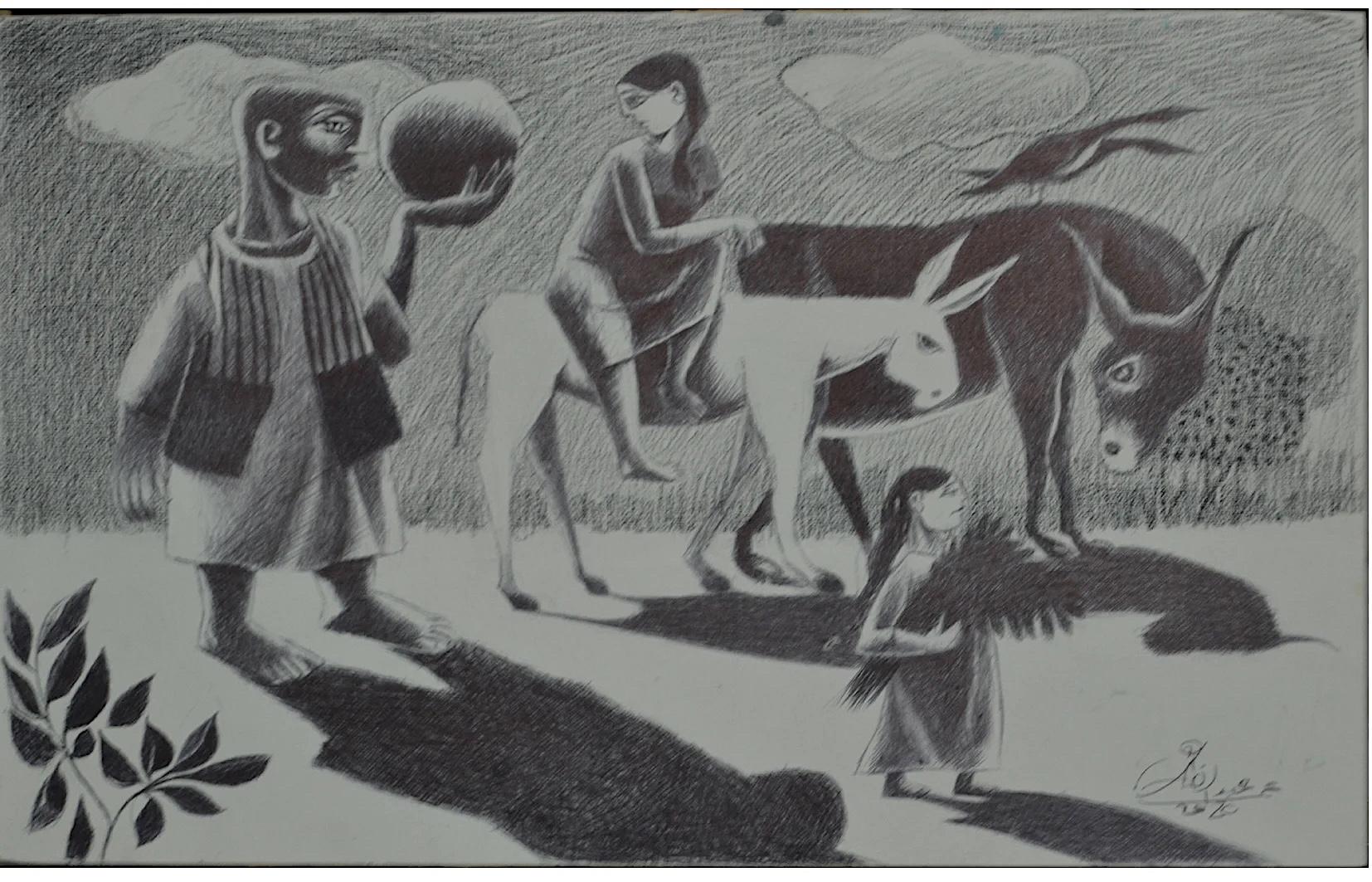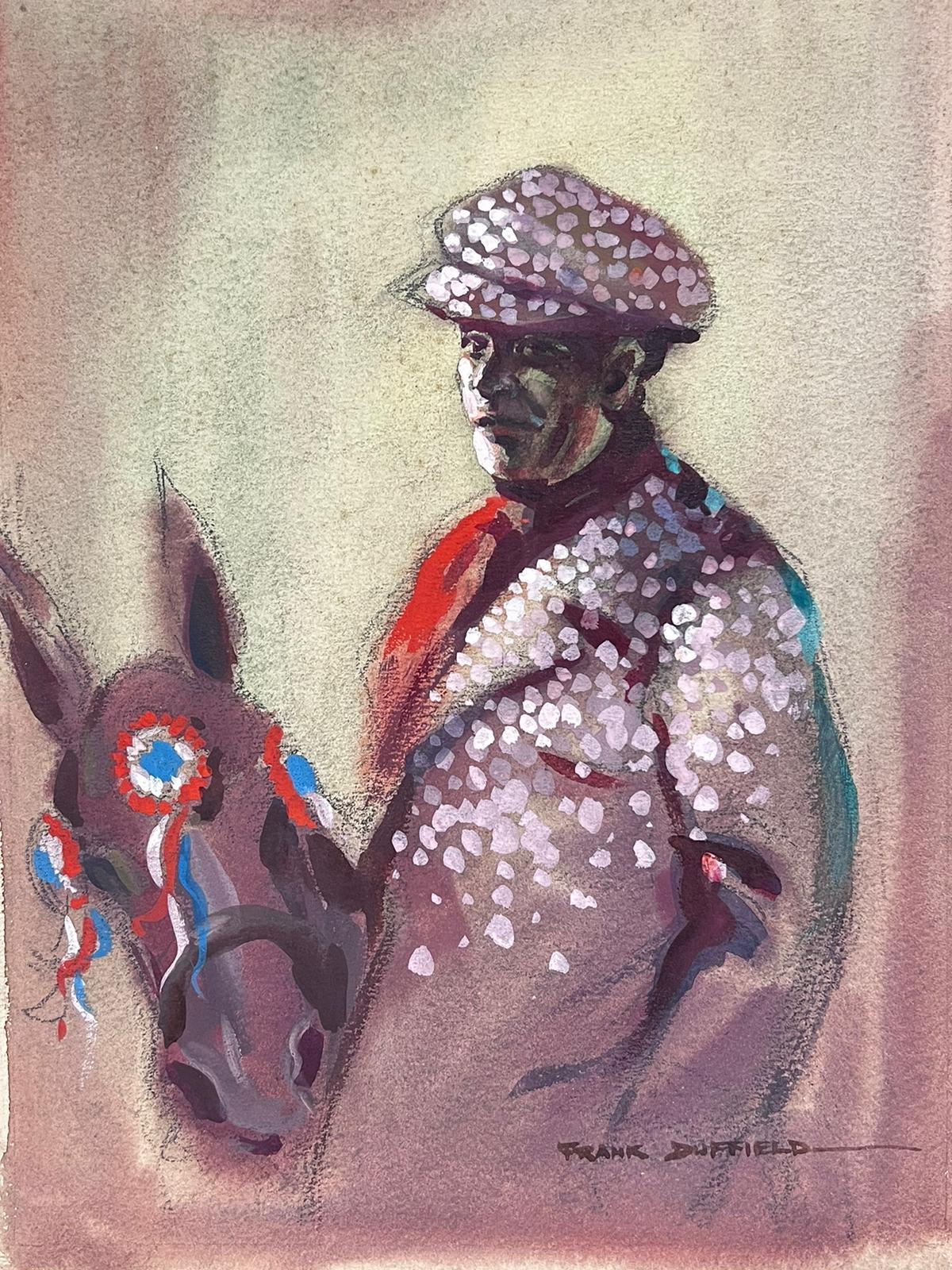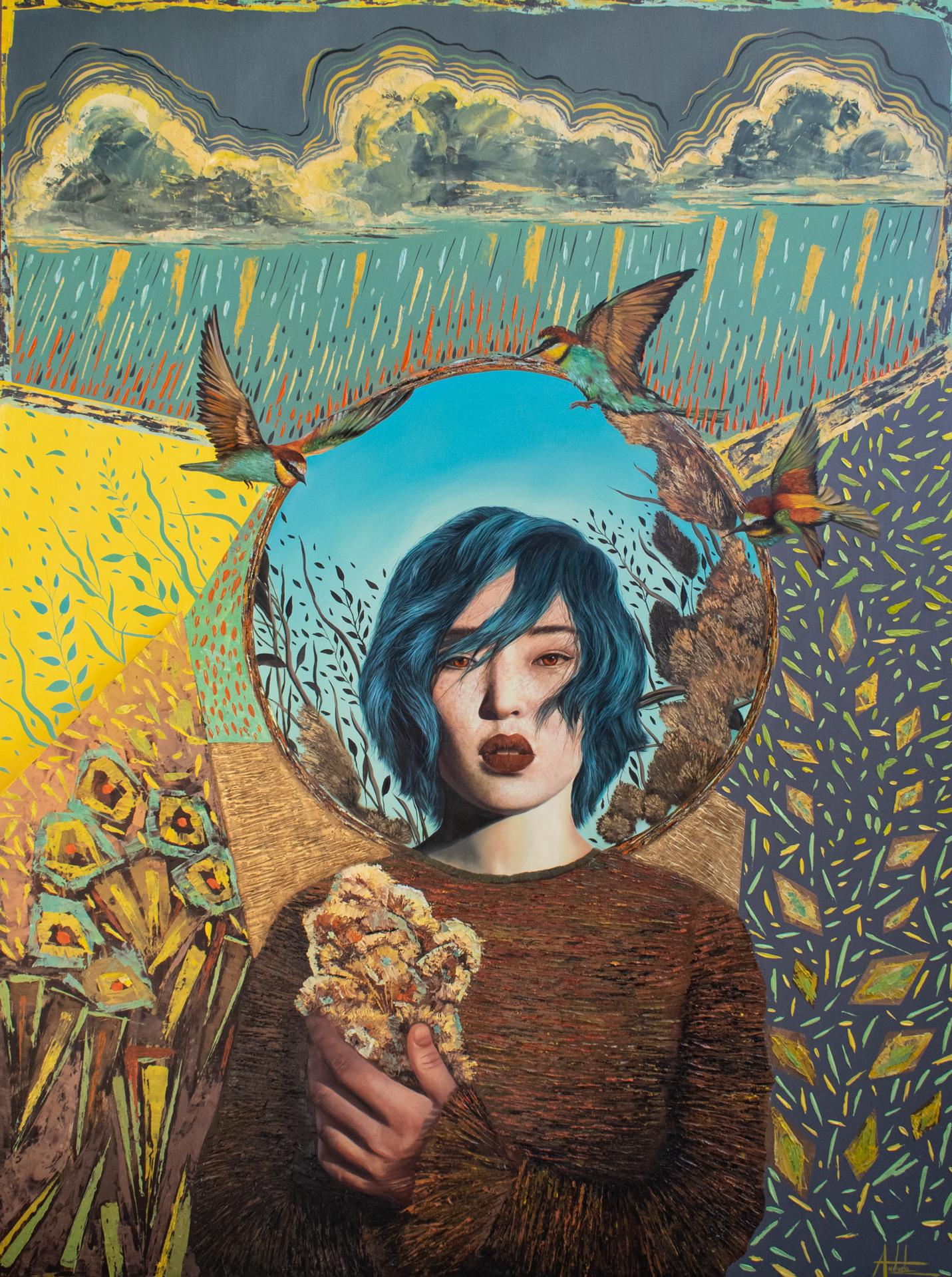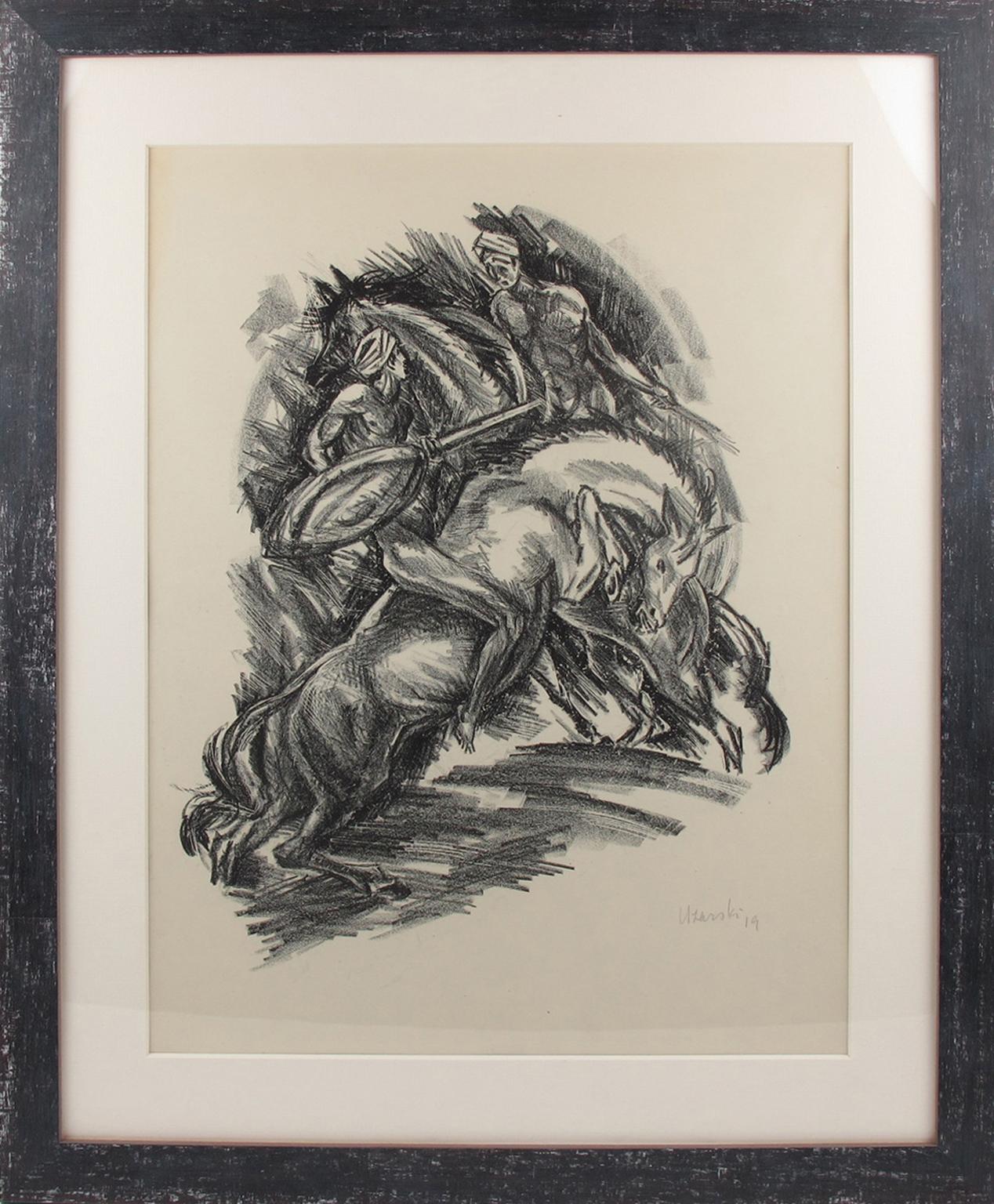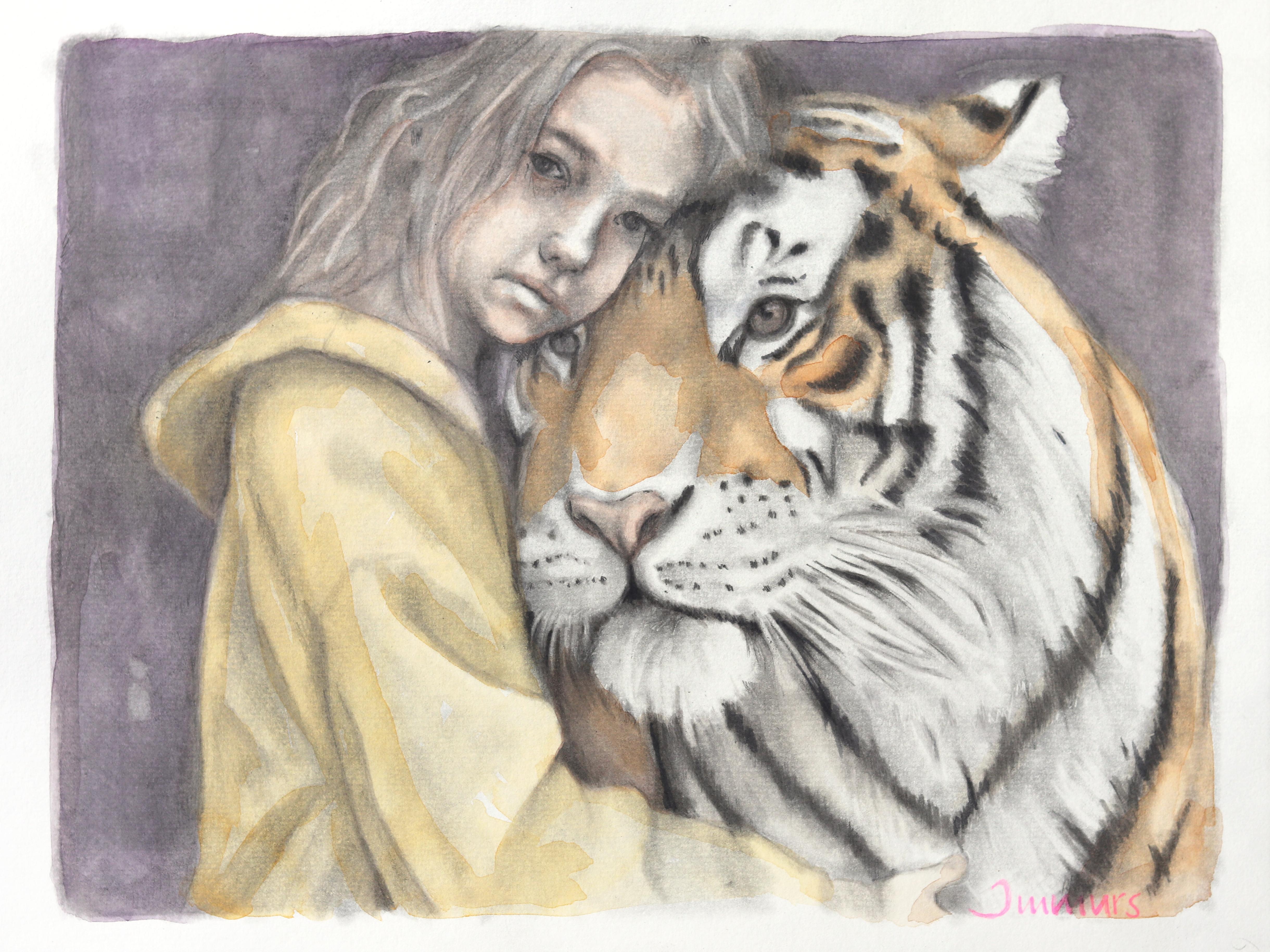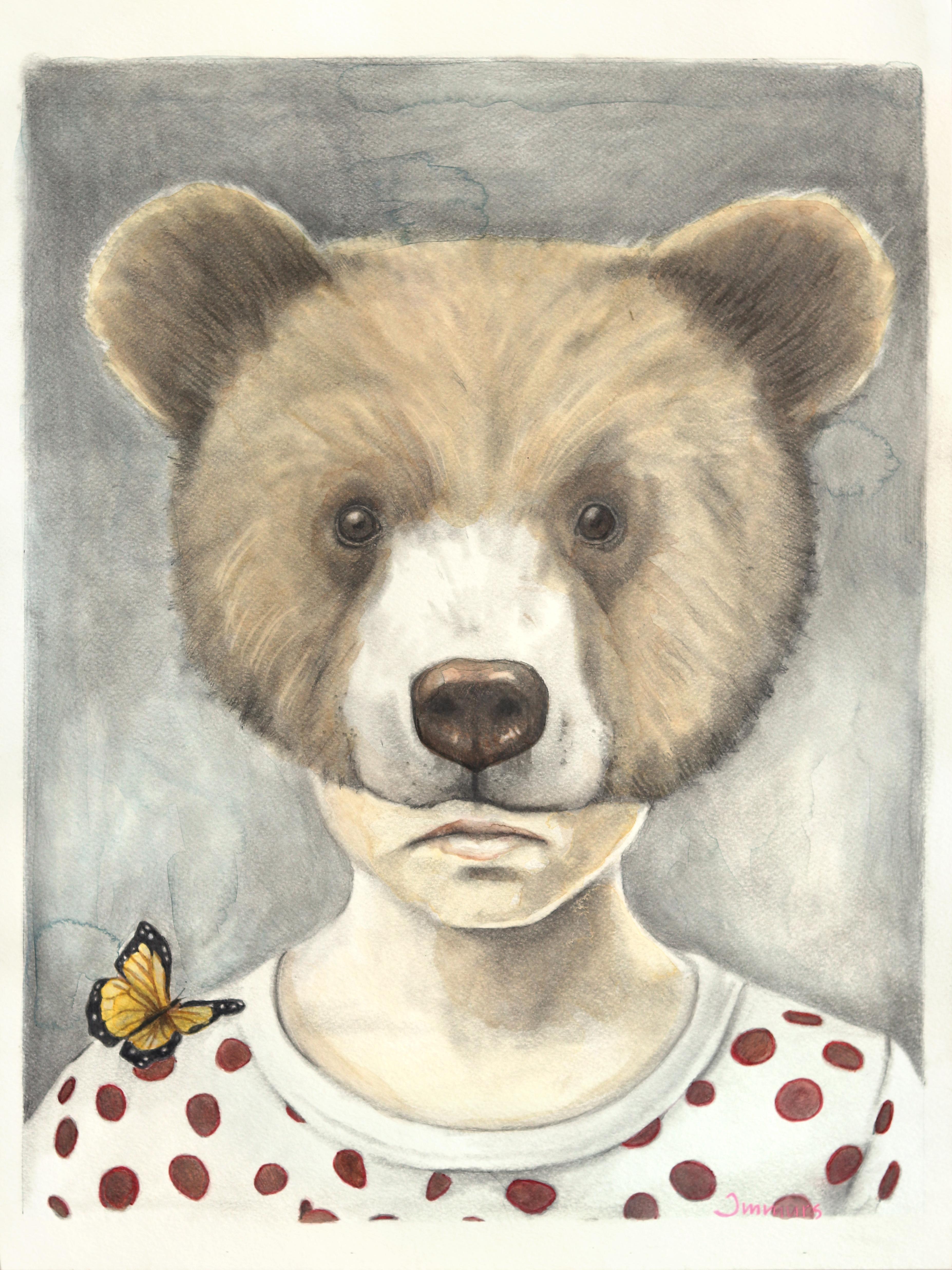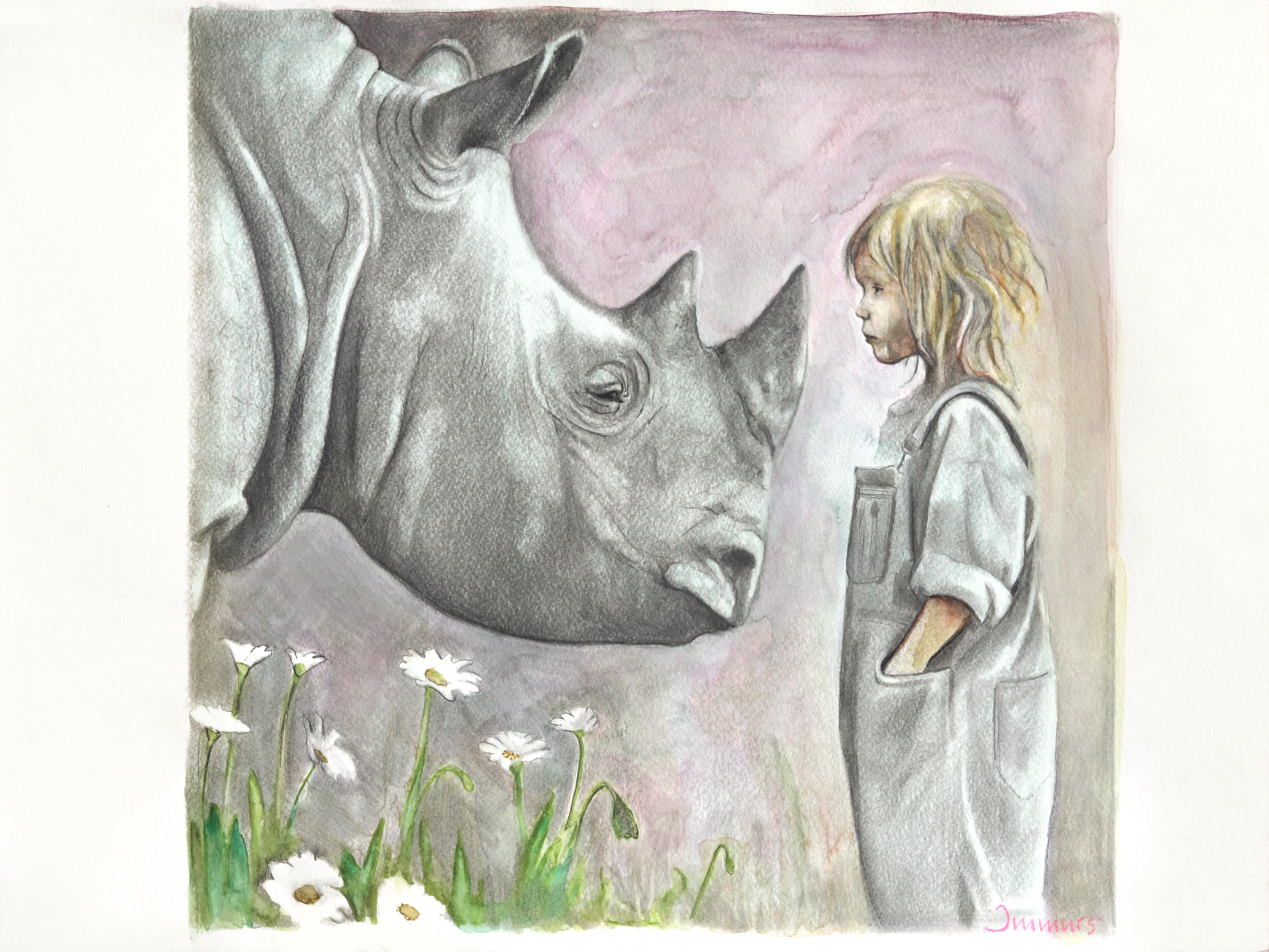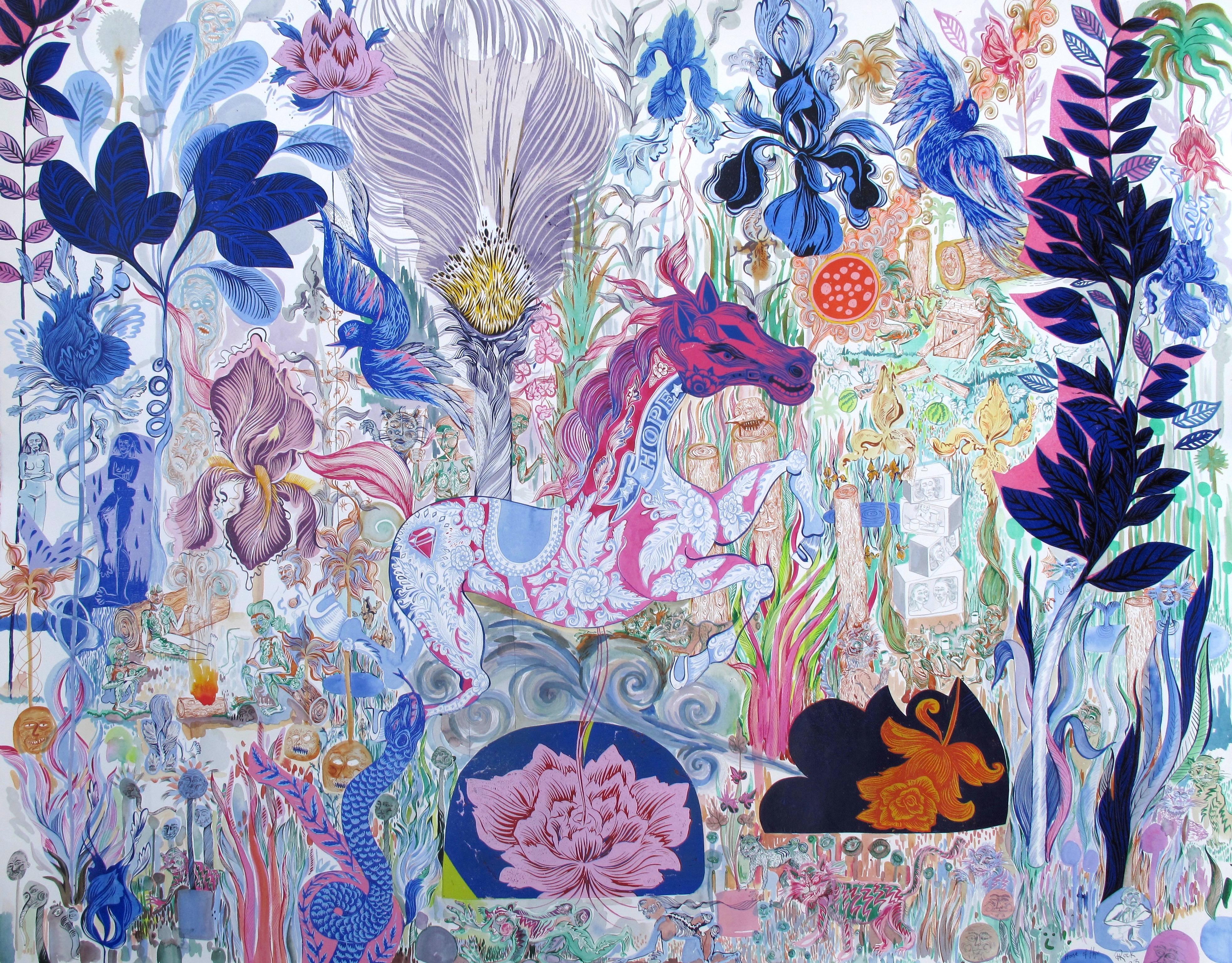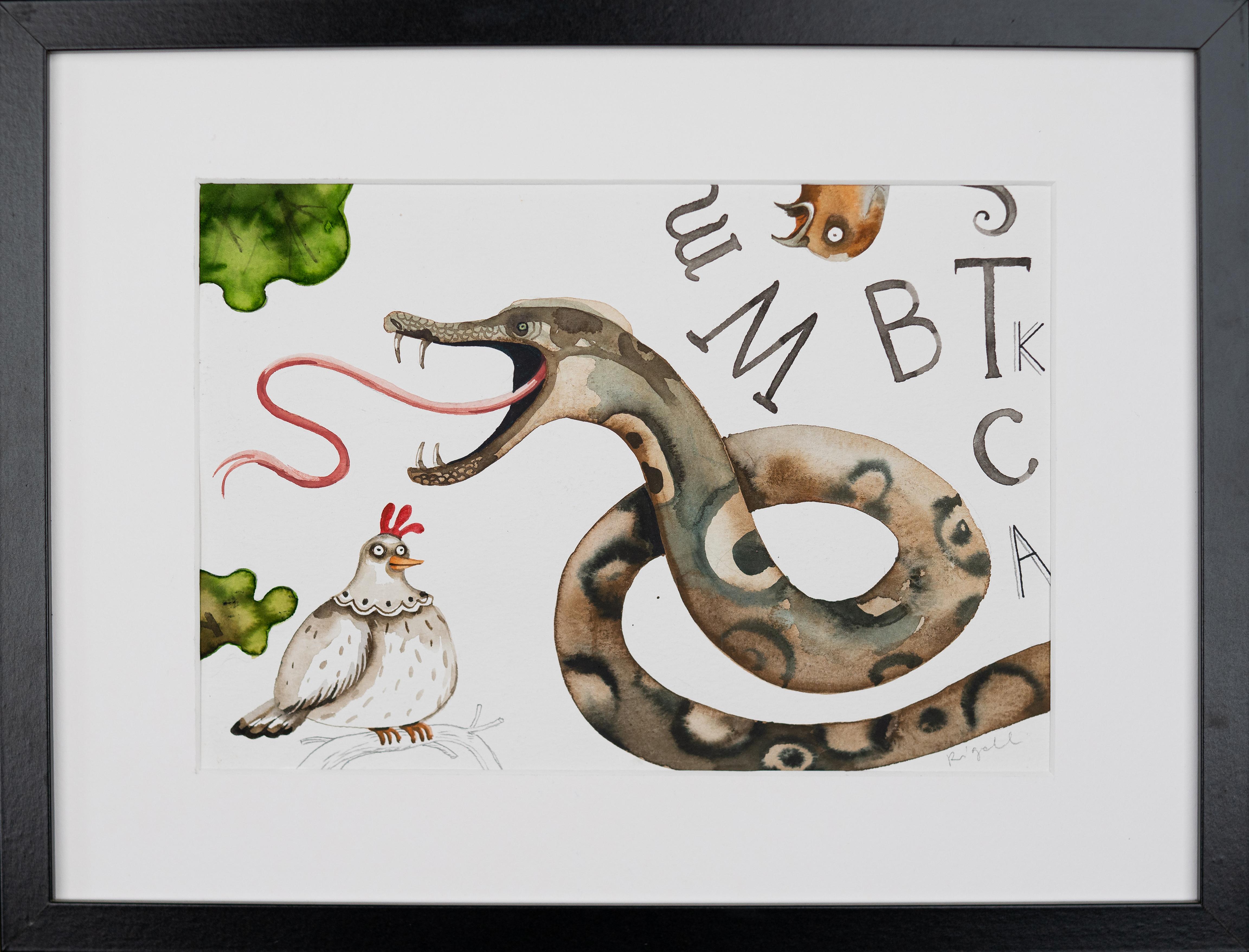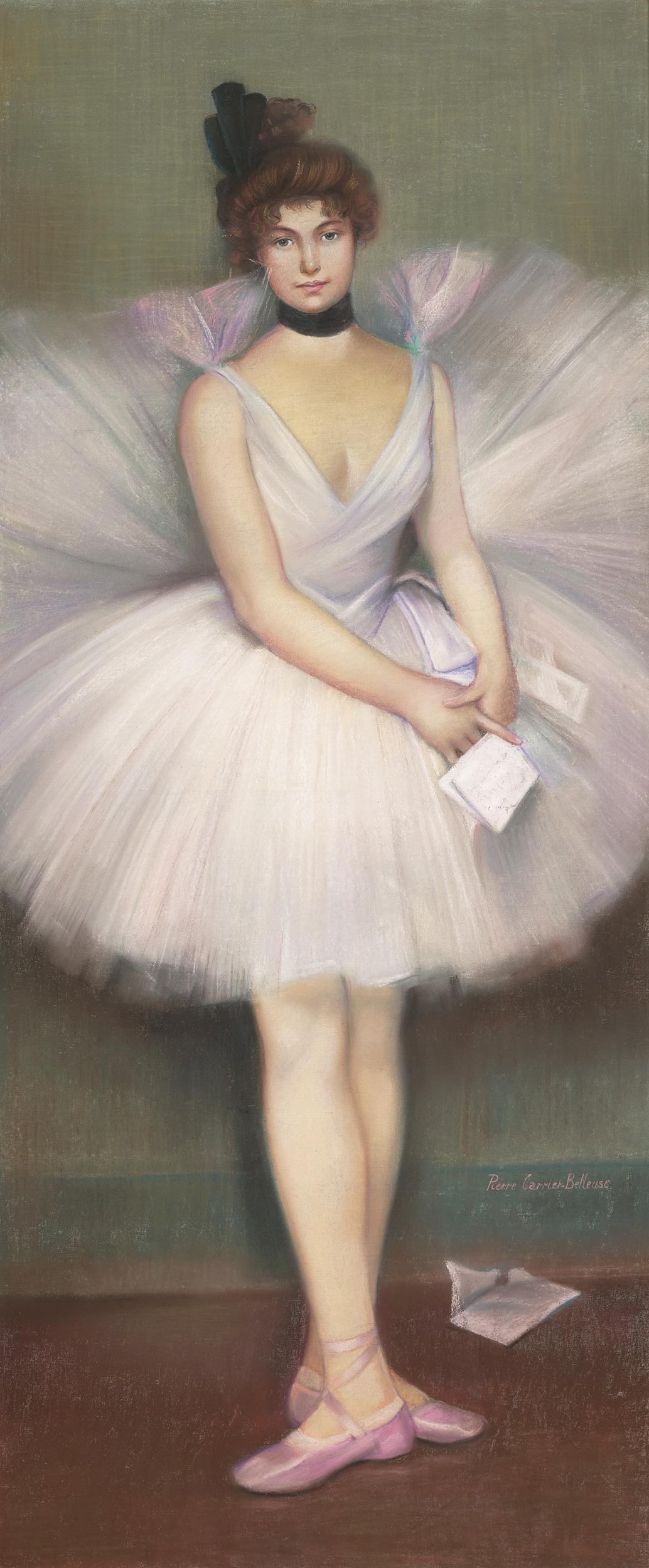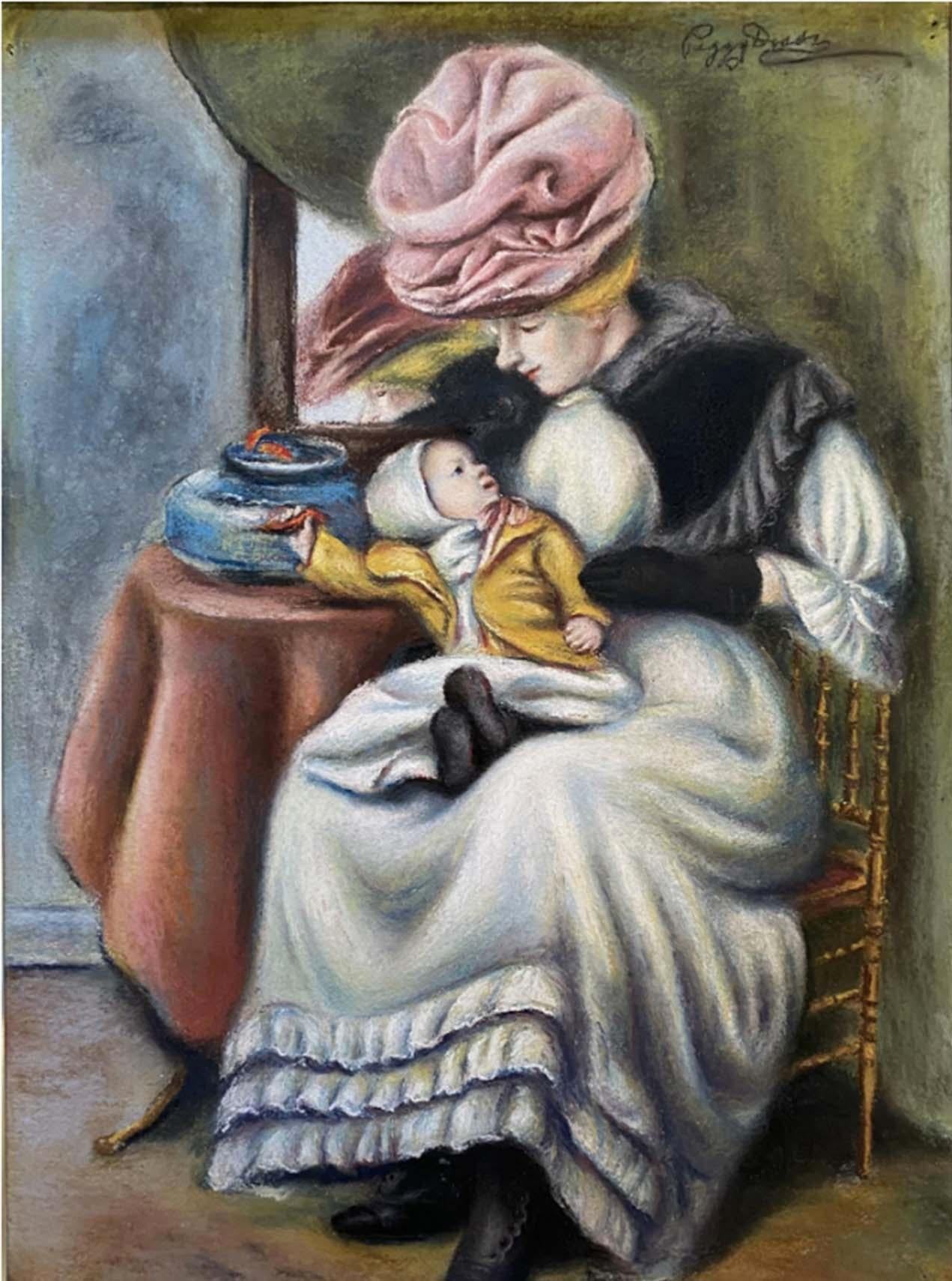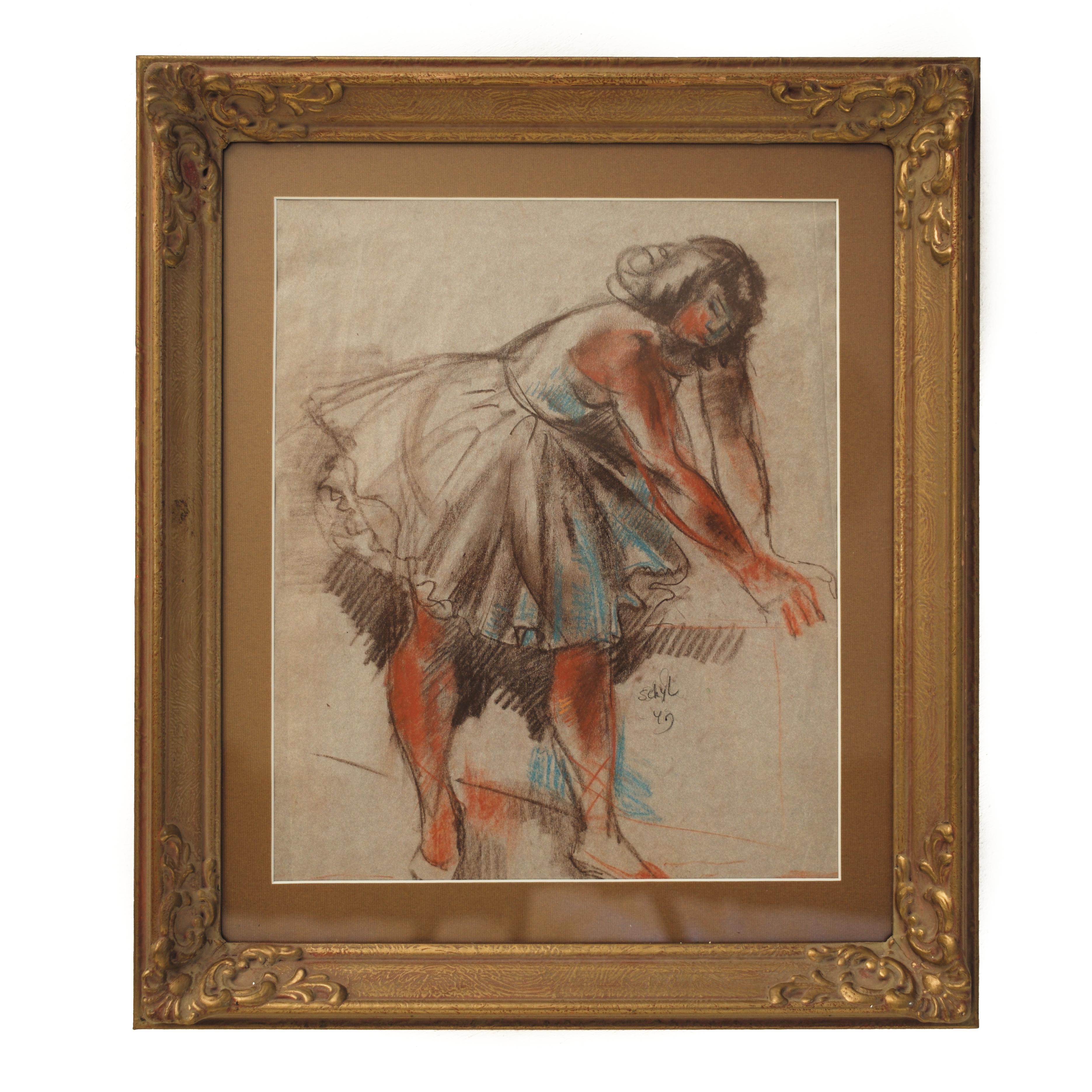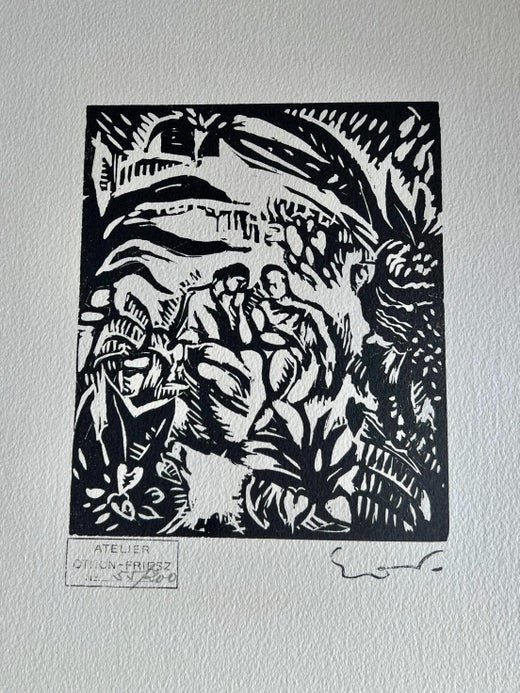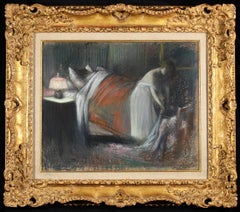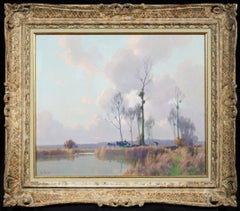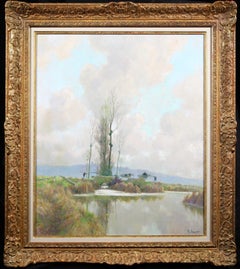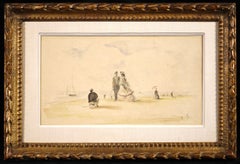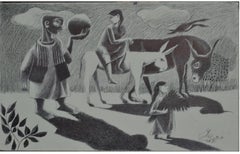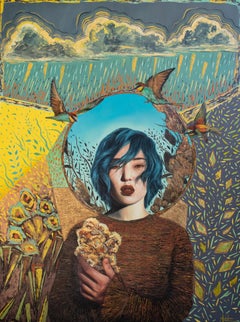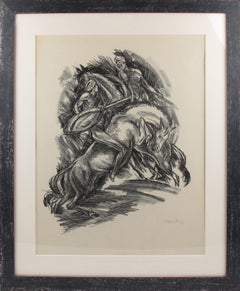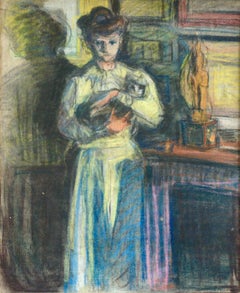
Young Girl with Cat
View Similar Items
Want more images or videos?
Request additional images or videos from the seller
1 of 14
Achille-Émile Othon FrieszYoung Girl with Cat1901
1901
About the Item
- Creator:Achille-Émile Othon Friesz (1879 - 1949, French)
- Creation Year:1901
- Dimensions:Height: 18 in (45.72 cm)Width: 15 in (38.1 cm)
- Medium:
- Movement & Style:
- Period:
- Condition:Very good condition.
- Gallery Location:Marlow, GB
- Reference Number:Seller: LFA00961stDibs: LU41534278682
Achille-Émile Othon Friesz
Othon Friesz was a native of Le Havre France 1879-1949. He was a French artist of the Fauvist movement. He was a good friend of Raoul Dufy and met Matisse, Marquet and Rouault and exhibited with them in 1907. In his later years he painted in a style very different than his earlier years. He respected Cezanne's style of logical composition, simple tonality, solidity of volume and distinct separation of planes and a baroque flavor to his style. He is known for Fauve and traditional painting, landscapes, still lifes and figurative style. He admired the works of modernists. Hi works are in major museums throughout the world.
About the Seller
5.0
Platinum Seller
Premium sellers with a 4.7+ rating and 24-hour response times
Established in 2001
1stDibs seller since 2016
703 sales on 1stDibs
Typical response time: 2 hours
Authenticity Guarantee
In the unlikely event there’s an issue with an item’s authenticity, contact us within 1 year for a full refund. DetailsMoney-Back Guarantee
If your item is not as described, is damaged in transit, or does not arrive, contact us within 7 days for a full refund. Details24-Hour Cancellation
You have a 24-hour grace period in which to reconsider your purchase, with no questions asked.Vetted Professional Sellers
Our world-class sellers must adhere to strict standards for service and quality, maintaining the integrity of our listings.Price-Match Guarantee
If you find that a seller listed the same item for a lower price elsewhere, we’ll match it.Trusted Global Delivery
Our best-in-class carrier network provides specialized shipping options worldwide, including custom delivery.More From This Seller
View AllLe Lever - Impressionist Figures in Interior Pastel by Jean Louis Forain
By Jean Louis Forain
Located in Marlow, Buckinghamshire
Signed impressionist figurative pastel on board circa 1895 by sought after French impressionist painter Jean Louis Forain. The piece depicts a man asleep in a bed while a woman stands at the foot of the bed getting dressed. The room is dimly lit by the bedside lamp.
Signature:
Signed upper right
Dimensions:
Framed: 22"x26"
Unframed: 15"x19"
Provenance:
Galerie Jean-Claude Bellier
Jean Forain was the son of a painter and decorator and was apprenticed to a visiting card engraver. He studied briefly under Gérôme and Carpeaux at the École des Beaux-Arts in Paris and regularly visited the Louvre, where he copied works by the masters. It is said that for a time he made a precarious living by selling small drawings in the style of Grévin. He went on to collaborate on various publications as a draughtsman and columnist, starting in 1876 on La Cravache and then collaborating on the newspapers Le Journal Amusant, Le Figaro and L'Écho de Paris. This introduced him to the diverse worlds of Paris society - the world of the theatre, of shows, and of literature - where he wryly noted the habits and shortcomings particular to each. This led him to follow a route very characteristic of this period, already seen in the work of Steinlen, Caran d'Ache and Toulouse-Lautrec in the journals La Pléiade, La Vogue and La Revue Blanche.
His work draws a picture of the society of the period, not in a strictly imitative fashion but in the form of the 'dessin-charge' or mild caricature. In 1880 he illustrated Parisian Sketches...
Category
Late 19th Century Impressionist Figurative Paintings
Materials
Pastel, Board
Marecages en Seine et Marne - Impressionist Riverscape Oil by Alexandre Jacob
By Alexandre Louis Jacob
Located in Marlow, Buckinghamshire
Signed oil on canvas landscape circa 1940 by popular French impressionist painter Alexandre Louis Jacob. The piece depicts workers loading wood onto a cart being pulled by a white ho...
Category
1940s Impressionist Landscape Paintings
Materials
Canvas, Oil
Avant Printemps au Marais - Impressionist Riverscape Oil by Alexandre Jacob
By Alexandre Louis Jacob
Located in Marlow, Buckinghamshire
Signed oil on canvas landscape circa 1950 by popular French impressionist painter Alexandre Louis Jacob. The piece depicts horses and their carts being led across small stone bridges...
Category
1950s Impressionist Landscape Paintings
Materials
Oil, Canvas
Sur la plage de Deauville - Impressionist Figurative Watercolor by Eugene Boudin
By Eugène Louis Boudin
Located in Marlow, Buckinghamshire
Signed watercolour on paper landscape circa 1865 by French impressionist painter Eugene Boudin. This work depicts an artist painting a portrait of an elegant couple on the beach at D...
Category
1860s Impressionist Figurative Drawings and Watercolors
Materials
Paper, Watercolor
L'embarquement de boeufs - Impressionist Oil, Cattle by Jean Francois Raffaelli
By Jean-Francois Raffaelli
Located in Marlow, Buckinghamshire
Wonderful signed oil on panel cattle and figures in landscape by French impressionist painter Jean-Francois Raffaelli. The work depicts oxen being loaded onto ships in Honfleur, France en route to England.
Signature:
Signed lower right
Dimensions:
Framed: 18"x16"
Unframed: 9"x8"
Provenance:
Exhibition Jean Francois Raffaélli held at Galerie Simonson, 19 Rue Caumartin Paris - October 1929 (number 44)
Jean-François Raffaëlli's father was a failed Italian businessman and Raffaëlli himself was, among other things, a church chorister, actor and theatre singer. He then studied under Gérôme at the École des Beaux-Arts in Paris. He travelled to Italy, Spain and Algeria and on his return to France settled in Asnières.
In 1876, on a trip to Brittany, he first saw the potential of realist subject matter, if treated seriously. He became involved in meetings of artists at the Café Guerbois, where the Impressionist painters used to gather. As a result, Degas, contrary to the advice of the group, introduced Raffaëlli to the Impressionist exhibitions - according to one uncertain source as early as the very first exhibition, at the home of Nadar, and certainly to those of 1880 and 1881.
In 1904, Raffaëlli founded the Society for Original Colour Engraving. He first exhibited at the Salon de Paris in 1870 and continued to exhibit there until he joined the Salon des Artistes Français in 1881, where he earned a commendation in 1885, was made Chevalier of the Légion d'Honneur in 1889 and in the same year was awarded a gold medal at the Exposition Universelle. In 1906 he was made Officier of the Légion d'Honneur. He was also a member of the Société Nationale des Beaux-Arts. In 1884, a private exhibition of his work cemented his reputation.
He contributed to several newspapers such as The Black Cat (Le Chat Noir) in 1885 and The French Mail (Le Courrier Français) in 1886 and 1887. He published a collection entitled Parisian Characters, which captured his favourite themes of the street, the neighbourhood and local people going about their lives. In 1880 he participated, with Forain, on the illustration of Joris Karl Huysmans' Parisian Sketches (Croquis Parisiens). He also illustrated Huysman's Works. As well as working as an illustrator, he also made etchings and coloured dry-points.
His early attempts at painting were genre scenes, but once he was settled in Asnières he started to paint picturesque views of Parisian suburbs. From 1879 onwards, his subject matter drew on the lives of local people. These popular themes, which he treated with humanity and a social conscience, brought him to the attention of the social realist writers of the time such as Émile Zola. In addition to his realist style, Raffaëlli's dark palette, which ran contrary to the Impressionist aesthethic, helped to explain the opposition of those painters to his participation in their exhibitions. More concerned with drawing than colour, he used black and white for most of his paintings. Towards the end of his life, he lightened his palette, but without adopting any other principles of the Impressionist technique.
After painting several portraits, including Edmond de Goncourt and Georges Clémenceau, he returned to genre painting, particularly scenes of bourgeois life. Later in his career, he painted mainly Breton-inspired sailors and views of Venice. His views of the Paris slums and the fortifications, sites which have almost completely disappeared, went some way towards establishing a genre in themselves and perpetuated the memory of the area: The Slums, Rag-and-Bone Man, Vagabond, Sandpit, In St-Denis, Area of Fortifications. His realistic and witty portrayal of typical Parisian townscapes accounts for his enduring appeal.
Born in Paris, he was of Tuscan descent through his paternal grandparents. He showed an interest in music and theatre before becoming a painter in 1870. One of his landscape paintings was accepted for exhibition at the Salon in that same year. In October 1871 he began three months of study under Jean-Léon Gérôme at the École des Beaux-Arts in Paris; he had no other formal training.
Raffaëlli produced primarily costume pictures until 1876, when he began to depict the people of his time—particularly peasants, workers, and ragpickers seen in the suburbs of Paris—in a realistic style. His new work was championed by influential critics such as J.-K. Huysmans, as well as by Edgar Degas.
The ragpicker became for Raffaëlli a symbol of the alienation of the individual in modern society. Art historian Barbara S. Fields has written of Raffaëlli's interest in the positivist philosophy of Hippolyte-Adolphe Taine, which led him to articulate a theory of realism that he christened caractérisme. He hoped to set himself apart from those unthinking, so-called realist artists whose art provided the viewer with only a literal depiction of nature. His careful observation of man in his milieu paralleled the anti-aesthetic, anti-romantic approach of the literary Naturalists, such as Zola and Huysmans.
Degas invited Raffaëlli to participate in the Impressionist exhibitions of 1880 and 1881, an action that bitterly divided the group; not only was Raffaëlli not an Impressionist, but he threatened to dominate the 1880 exhibition with his outsized display of 37 works. Monet, resentful of Degas's insistence on expanding the Impressionist exhibitions by including several realists, chose not to exhibit, complaining, "The little chapel has become a commonplace school which opens its doors to the first dauber to come along."An example of Raffaëlli's work from this period is Les buveurs d'absinthe (1881, in the California Palace of Legion of Honor Art Museum in San Francisco). Originally titled Les déclassés, the painting was widely praised at the 1881 exhibit.
After winning the Légion d'honneur in 1889, Raffaëlli shifted his attention from the suburbs of Paris to city itself, and the street scenes that resulted were well received by the public and the critics. He made a number of sculptures, but these are known today only through photographs.[2] His work was also part of the painting event in the art competition at the 1912 Summer Olympics. In the later years of his life, he concentrated on color printmaking. Raffaëlli died in Paris on February 11, 1924
Museum and Gallery Holdings:
Béziers: Peasants Going to Town
Bordeaux: Bohemians at a Café
Boston: Notre-Dame; Return from the Market
Brussels: Chevet of Notre-Dame; pastel
Bucharest (Muz. National de Arta al României): Market at Antibes; Pied-à-terre
Copenhagen: Fishermen on the Beach
Douai: Return from the Market; Blacksmiths
Liège: Absinthe Drinker...
Category
1880s Impressionist Animal Paintings
Materials
Oil, Panel
The Great War - Impressionist Oil, Figure & Horse in Landscape by Andre Devambez
By André Devambez
Located in Marlow, Buckinghamshire
Wonderful oil on panel circa 1920 by French impressionist painter Andre Devambez. The work depicts a soldier leading his horse along a dirt track during...
Category
1910s Impressionist Animal Paintings
Materials
Oil, Panel
You May Also Like
"Watermelon Vendor with Mules" Drawing 12" x 16" inch by Omar Abdel Zaher
Located in Culver City, CA
"Watermelon Vendor with Mules" Drawing 12" x 16" inch by Omar Abdel Zaher
Abdel Zaher is a graduate of the Academy of Fine Arts in Helwan and has been painting for three decades and...
Category
21st Century and Contemporary Impressionist Figurative Drawings and Wate...
Materials
Paper, Pencil
Portrait of Man with Prize Winning Horse 20thC Impressionist Painting
Located in Cirencester, Gloucestershire
Frank Duffield (British, 1908-1982)
signed original gouache painting on board, unframed
size: 16 x 13 inches
condition: overall very good, minor wear to the edges as is normal for an...
Category
Mid-20th Century Impressionist Figurative Drawings and Watercolors
Materials
Gouache
"Eye of the Storm" - Mixed Media Artwork by Andrada Trapnell, Surreal Portrait
Located in Denver, CO
"Eye of the Storm," an original mixed media artwork by Andrada Trapnell, measures 40 x 30 inches and is rendered on a sturdy board. Created in 2023, t...
Category
2010s Realist Figurative Drawings and Watercolors
Materials
Panel, Mixed Media
Art Deco Fantasy Illustration Charcoal Drawing Lithograph by Adolf Uzarski
Located in Atlanta, GA
German Artist Adolf Uzarski (1885 - 1970) designed this stunning charcoal drawing lithograph print on paper, depicting two riders in a wild dance or fight. This drawing is part of five lithographs set to illustrate scenes from the 14th Century Tutinama, a Persian series of 52 stories, also known as "Tales of the Parrot."
Tales of adventures told by a parrot, night after night, for 52 successive nights, are moralizing tales to persuade its owner not to commit adultery misconduct with a lover in her husband's absence.
Hand-written signature on bottom right corner: "Uzarski - 19".
The lithograph is ornate with a contemporary wood frame and an acrylic glass protection.
Measurements:
With frame: 24.75 in wide (63 cm) x 29.75 in high (75.5 cm)
Opening view: 16.94 in wide (43 cm) x 22.50 in high (57 cm).
We have a set of five different pieces from the same artist.
If you are interested in purchasing multiples to form a cluster, kindly inquire. Examine the ambiance image with two artworks.
Biography: Adolf Uzarski (1885 - 1970) was a German writer, artist, and illustrator associated with the "New Objectivity Movement."
He was born in Ruhrort bei Duisburg (1885) and studied at the Cologne School of Architecture before enrolling in 1906 at the Düsseldorf School of Arts and Crafts. Before World War I, he exhibited in Berlin and Hagen and became a successful commercial artist. While directing the advertising department of the Tietz department store in 1916–17, he produced the portfolio of lithographs, Totentanz (Danse Macabre - Dance of Death). Beginning in 1919, he exhibited with "Das Junge Rheinland" (Young Rhineland), of which he was a founding member. This stylistically diverse group, which included Arthur Kaufmann...
Category
1910s Art Deco Figurative Drawings and Watercolors
Materials
Paper, Charcoal
How To Capture This Feeling - Whimsical Figurative Watercolor Graphite Artwork
Located in Los Angeles, CA
Amanda Immurs, an artist hailing from Hamilton, Canada, creates enchanting watercolor artworks that bring whimsical scenes of children, animals, and flora to life. Immurs' art is gro...
Category
2010s Modern Figurative Drawings and Watercolors
Materials
Paper, Watercolor, Graphite
If They Look Close Enough They'll Find Her - Figurative Watercolor Artwork
Located in Los Angeles, CA
Amanda Immurs, an artist hailing from Hamilton, Canada, creates enchanting watercolor artworks that bring whimsical scenes of children, animals, and flora to life. Immurs' art is gro...
Category
2010s Modern Figurative Drawings and Watercolors
Materials
Paper, Watercolor, Graphite
Recently Viewed
View AllMore Ways To Browse
Estampe Moderne
Matisse Cat
La Grande Dame
Antique Swedish Fireplace
Fireplace Cat
Emile Othon Friesz
Oiseaux Braque
Vasa Painting
Achille Emile Othon Friesz
Side X Side Gallery
Dior Germany
Street Scene Painting
Vintage Modernist Painting
Oil Painting Of A Field
Modern Print 30x40
Almost Home
Small Painting Black
Lush Art
